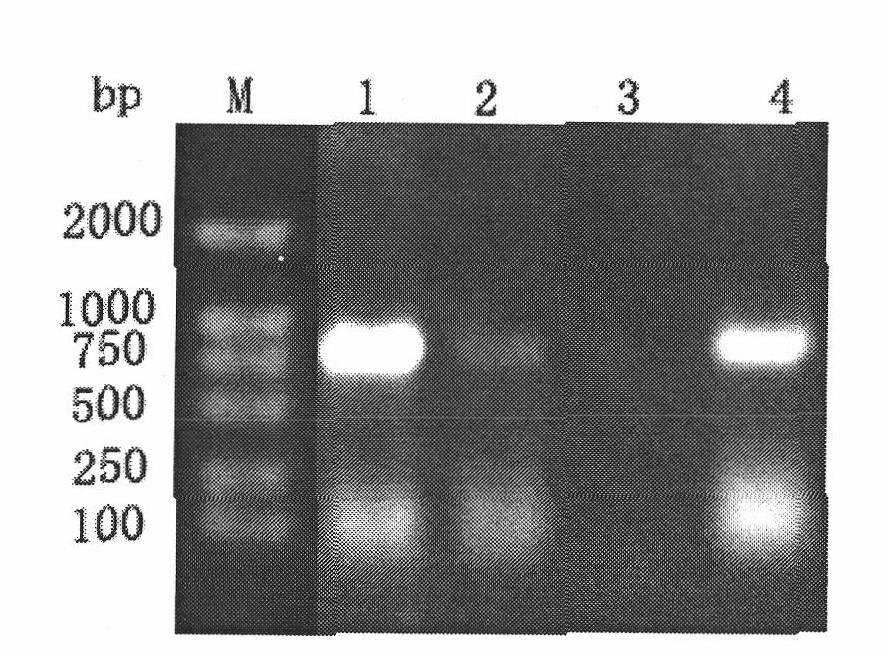Surface display and application of yeast of white spot syndrome virus (WSSV) VP37
A technology for vitiligo syndrome and VP37, applied in the field of genetic engineering, can solve problems such as unreported, and achieve the effects of good stability, simple and easy cultivation method, and convenient large-scale production.
- Summary
- Abstract
- Description
- Claims
- Application Information
AI Technical Summary
Problems solved by technology
Method used
Image
Examples
Embodiment 1
[0037] Embodiment 1: VP37 gene amplification
[0038] The PCR primers were synthesized by Shanghai Bioengineering Co., Ltd., and the following reaction system was established in a PCR tube:
[0039] 10×Buffer 2.5μl; dNTP 2.0μl; WSSVDNA template 1.0μl; 37-a (10pmol / μl) 1.0μl; 37-s (10pmol / μl) 1.0μl; rTaq enzyme (5U / μl) 0.5μl; ddH 2 O 17 μl.
[0040] The PCR reaction program was: denaturation at 94°C for 5min; 35 cycles of 94°C for 40s, 56°C for 40s, and 72°C for 40s; extension at 72°C for 5min. After the reaction, 5 μL of the PCR reaction product was added to 1 μL of a mixture of loading buffer (loading buffer) and Gene finder (1:9), and detected by electrophoresis on a 1.0% agarose gel containing Genefinder. The size of the PCR product is 800bp, and the result identification is shown in the description of the accompanying drawings and the accompanying drawings of the present invention. figure 1 . The amplified fragment was sequenced by Dalian Bao Biology Co., Ltd., and the...
Embodiment 2
[0041] Embodiment 2: Construction of recombinant vector
[0042] The PCR product was double-digested with EcoR I and Xho I, and the vector pYD1 was also double-digested with EcoR I and Xho I. After the results of the enzyme digestion were identified by electrophoresis, they were recovered and purified using the gel recovery kit of Bao Bio-Engineering Co., Ltd. Plasmid pYD1 and VP37 gene fragments, the recovered double enzyme digested and purified products (VP37 and pYD1) were treated with T 4 For DNA Ligase connection, the material ratio of the carrier to the target fragment is 1:8-1:10. Add 25 μl of the above ligation product to Top10 competent cells, heat shock in a water bath at 42°C for 45 seconds, and then quickly place it on ice for 1 minute, add a certain amount of LB medium (without Amp) to 1000 μl, and culture on a shaker at 37°C for 1 hours to restore resistance; apply 200 μl of the transformed bacteria solution to the solid LB medium containing Amp (50 μg / ml), and ...
Embodiment 3
[0043] Example 3: Transformation of yeast competent cells by VP37-pYD1
[0044] Take 100 μl EBY100 competent cells (1×10 8 Cells / ml) and 5 μl pYD1-VP37 recombinant plasmid (0.1 μg / μl) were mixed in the EP tube, then added lithium acetate conversion solution (1 mmol / L liAc, 40% PEG3350, 1 × TE), shaken for 10 seconds, 30 ℃ water bath for 30 minutes; then add dimethyl sulfoxide, after 42 ℃ water bath for 7 minutes, centrifuge at 14000r / min for 5 seconds, discard the supernatant, and resuspend the cells with 0.5ml TE buffer. Take 100 μl of cell suspension and spread it on YNB (Leu) auxotroph selection plate lacking tryptophan (0.5-0.7% YNB, 1.0-2.0% glucose, 0.005-0.01% leucine, 1.5-2.0% agar) , cultured at 25-30° C. for 24-48 hours, and successfully transformed yeast colonies were obtained. In the same way, the competent cells were transformed with the empty vector pYD1 as a negative control for not expressing the target gene product.
PUM
 Login to View More
Login to View More Abstract
Description
Claims
Application Information
 Login to View More
Login to View More - R&D
- Intellectual Property
- Life Sciences
- Materials
- Tech Scout
- Unparalleled Data Quality
- Higher Quality Content
- 60% Fewer Hallucinations
Browse by: Latest US Patents, China's latest patents, Technical Efficacy Thesaurus, Application Domain, Technology Topic, Popular Technical Reports.
© 2025 PatSnap. All rights reserved.Legal|Privacy policy|Modern Slavery Act Transparency Statement|Sitemap|About US| Contact US: help@patsnap.com



